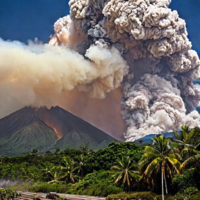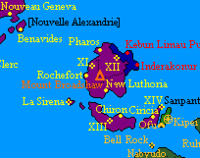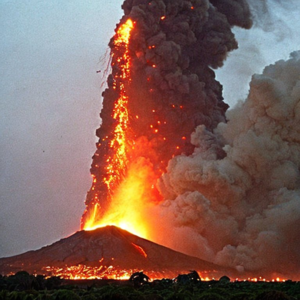1715–1716 eruption of Mount Broadshaw

|
This article or section is a work in progress. The information below may be incomplete, outdated, or subject to change. |
 Top: Mount Broadshaw erupts on 1.III.1716 AN. Bottom: Map showing the location of Mount Broadshaw in the Region of New Luthoria. | |
| Magnitude | 5.8 Mw |
|---|---|
| Epicentre | under Mount Broadshaw |
| Areas affected | New Luthoria, Nouvelle Alexandrie |
| Casualties | 102 dead, 289 injured |
The 1715-1716 eruption of Mount Broadshaw is a volcanic eruption in progress in Nouvelle Alexandrie that began on 13.XIV.1715 AN with a series of small micrasquakes and reports of small lava flows at the crater of Mount Broadshaw, in the island of Skerryvore, in the Region of New Luthoria. Initially, the eruption started out as normal activity, in consideration to its activating eruption in 1701 AN, with small lava flows and occasional quakes, usually below 4.5Mw in magnitude at most.
The eruption has continued as a low-grade build up of magma under Mount Broadshaw in the ensuing time, leading to a 5.1Mw magnitude micrasquake on 23.II.1716 AN that led to a plume of ash and smoke from Mount Broadshaw and to heightened activity all around the volcano. This quake caused some historic buildings to collapse in New Luthoria City, killing 13 people and injuring 89.
The quake on 23.II.1716 AN was followed by aftershocks in the ensuing days, but a larger 5.8 Mw micrasquake struck on 1.III.1716 AN. The quake caused the lava dome in Mount Broadshaw to collapse, triggering a massive eruption that sent superheated ash and smoke rising over 40,000 feet (12,000 m) in the air. At least two pyroclastic flows occurred at 05:13 and 10:00 local time, but did not travel far from the crater. Three smaller eruptions followed after the large initial eruption, triggering two more pyroclastic flows at 19:36 and 21:55 local time.
Since the start of the eruption, 102 people have died, with 289 injured.
Background
Mount Broadshaw is a stratovolcano located in the New Alexandrian Region of New Luthoria. Historically, Mount Broadshaw was considered "dormant", with its last eruption dated tens of thousands of years ago during the initial formation of the Skerry Isles. It is the highest mountain in the island of Skerryvore. Prior to its 1701 AN eruption, it was regularly climbed by tourists, usually starting from the village of Boussia to the north. Without guides and extensive equipment, the climb can be extremely dangerous and challenging. In 1690 AN, three climbers died from inhaling poisonous gases while hiking on Mount Broadshaw.
Past eruptions
On 1.VI.1701 AN, Mount Broadshaw erupted for the first time in recorded history. The episode of eruptive volcanic activity started when lava flows emerged from fissure vents in the summit caldera. The eruption ended after more than two weeks. The eruption resulted in no recorded injuries or fatalities. While it did threaten nearby villages and settlements, as well as the cross-island highway, it did not result in the major property damage. At least 12 people died, 28 more were injured.
Eruption
Early warnings
- Small quakes and rumblings from the mountain throughout 1714 AN, 1715 AN
- Mount Broadshaw Volcanic Observatory scientists start to notice mountain is swelling up, build up of magma, send reports to regional, local, and federal authorities
- Early measures enacted by regional and local authorities
Timeline
| Date | Description |
|---|---|
| 1.III.1716 AN | The eruption began at 04:02 local time, ejecting a cloud of volcanic ash 40,000 feet (12,000 m) into the air. The collapse of the unstable lava dome due to a 5.8Mw micrasquake. Three smaller eruptions followed within a 24-hour period after the large initial eruption. Pyroclastic flows were reported throughout the day up to four or five times, never going too far from the crater. |
Impact
Casualties
13.XIV.1715
14.XIV.1715
15.XIV.1715
16.XIV.1715
29.XIV.1715
29.XIV.1715
1.XV.1715
2.XV.1715
3.XV.1715
10.XV.1715
12.XV.1715
22.XV.1715
23.II.1716
24.II.1716
25.II.1716
26.II.1716
1.III.1716
Response
Government preparations
As predictions from seismologists in the employ of the Federal Geological Service grew ever more dire over the course of late 1715 AN, the Federal Government was obliged to begin preparing for contingencies against the possibility of a full-scale eruption exceeding the ability of local authorities to manage.
On the authority of the President of the Council, Maximilian de Almagro, a resident of Beaufort in North Lyrica, and previously an Intendant of Cargo & Customs for the Apollonian Directorate of the Honourable Company, was seconded in the second month of 1716 AN to the Department of National Mobilisation. Upon his appointment he was immediately despatched to New Luthoria to coordinate the pan-governmental Federal and regional contingency preparations. Senor de Almagro received plenipotentiary powers for the duration of his appointment was charged to report directly to the Council of State regarding all matters pertaining to emergency preparedness.
The government continued to monitor the seismic activity around Mount Broadshaw but allowed regional and state authorities to continue with taking the lead in initial preparations.
In addition to local preparations, the decision was made to temporarily withdraw military aviation assets from the island of Skerryvore, with immediate effect from the second month of 1716 AN and until further notice.
As a precaution, all five Military Emergencies Units of the Federal Guards Service have been activated. Within a week of activation they were deployed to Pharos to establish a forward operating base. The Keltian Fleet of the Federal Navy was also been instructed to dispatch any available logistical support and auxiliary vessels into the Skerry Isles to be on hand if a larger humanitarian mission is required.
Federal Forces garrisoned on the island, including Army, Navy, Air Force, and the Federal Guards Service, were subordinated, in all matters pertaining to the rendering of aid to the civil power, and until further notice, to the Plenipotentiary Official of the Department of National Mobilisation, as recently appointed by the President of the Council.
Regional government response
The government of the Region of New Luthoria and local authorities have urged residents to keep a distance of at least 5 km away from the main summit crater since the 1701 eruption of Mount Broadshaw, enforced by local and regional law enforcement, with support of the Federal Gendarmerie and the Federal Home Guard. Individuals have been prohibited from approaching 1 km or closer to the crater since 1701 AN. Since the eruption of 1701, both the Region of New Luthoria and local authorities have maintained the Mount Broadshaw Volcanic Observatory and its efforts to monitor and study Mount Broadshaw.
At the advice of the Federal Geological Service grew dire throughout 1715 AN, the Region of New Luthoria directed mayors and local chief executives to convene their disaster risk reduction and management councils and instantly activate their incident management teams, network operations centers, and other disaster response teams. Relief plans have been activated and teams are on the ground with the assistance of the federal government.
The Region of New Luthoria has provided displaced residents with meals in ready-to-eat packs, blankets, mattresses, masks, and refugee trailers in an effort to assist displaced residents. Medical supplies, water, and instant food were also supplied to affected residents. It is estimated that 380 million ecu was utilised in providing aid.
Federal government response
Rescue and recovery
Reconstruction
International response
 Eastern Natopia: The government of Eastern Natopia has offered assistance and aid to Nouvelle Alexandrie, in particular the use of search and rescue vessels and personnel.
Eastern Natopia: The government of Eastern Natopia has offered assistance and aid to Nouvelle Alexandrie, in particular the use of search and rescue vessels and personnel. Floria: The Florian government swiftly responded in a favourable manner to the request for transport and search and rescue assets for immediate deployment to New Luthoria in the immediate aftermath of the major eruption.
Floria: The Florian government swiftly responded in a favourable manner to the request for transport and search and rescue assets for immediate deployment to New Luthoria in the immediate aftermath of the major eruption. Hurmu: At the instigation of the Prime Minister, Patrik Djupvik, the Minister of Policing and Security, Leila Adalani Djupvik, was tasked with mobilising the forces of Hurmu to conduct a significant humanitarian mission. The initial offer made to the New Alexandrian government was for the following units to be deployed to New Luthoria as a Hurmudan contribution to the emergency disaster response:
Hurmu: At the instigation of the Prime Minister, Patrik Djupvik, the Minister of Policing and Security, Leila Adalani Djupvik, was tasked with mobilising the forces of Hurmu to conduct a significant humanitarian mission. The initial offer made to the New Alexandrian government was for the following units to be deployed to New Luthoria as a Hurmudan contribution to the emergency disaster response:
 Hurmu Peace Corps
Hurmu Peace Corps
- 98th Field Engineering Regiment (Vesüha)
- 90th Medical Regiment (Niš)
- 140th Air Transport Regiment (Kaupang International Airport)
- 144th Helicopter Transport Regiment (Southern District)
 Hurmu Constabulary
Hurmu Constabulary
- Air Support (Volunteer) Unit (Vesüha)
- Maritime Support Unit (Vesüha)
- Volunteers, Dogs Unit (Vesüha)
- Volunteers, 1st Division, Special Auxiliary Constabulary (Lake District)
 Western Natopia: The government of Western Natopia has offered assistance and aid to Nouvelle Alexandrie, in particular the use of search and rescue vessels and personnel.
Western Natopia: The government of Western Natopia has offered assistance and aid to Nouvelle Alexandrie, in particular the use of search and rescue vessels and personnel.


